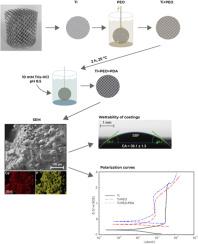A first look at the formation of PEO-PDA coatings on 3D titanium
引用次数: 0
Abstract
Additive manufacturing has revolutionized implantology by enabling the fabrication of customized, highly porous implants. Surface modifications using electrochemical methods can significantly enhance the bioactivity and biocompatibility of biomaterials, including 3D-printed implants. This study investigates novel coatings on 3D titanium (Ti) samples. Mesh Ti samples were designed and subjected to plasma electrolytic oxidation (PEO) to form a calcium phosphate coating. Subsequently, a layer of polydopamine (PDA) was applied. The electrochemical properties and morphology of the coatings were analyzed. Scanning electron microscopy (SEM) and energy-dispersive X-ray spectroscopy (EDS) revealed well-developed coatings containing calcium phosphates (including hydroxyapatite), titanium dioxide, and polymerized dopamine, suggesting promising bioactive potential. Composite layers incorporating PDA exhibited superior protective properties compared to base PEO coatings.

三维钛上 PEO-PDA 涂层的形成初探
增材制造技术通过制造定制化、高多孔性植入体,为植入学带来了革命性的变化。使用电化学方法进行表面改性可显著提高生物材料(包括三维打印植入物)的生物活性和生物相容性。本研究调查了三维钛(Ti)样品上的新型涂层。设计了网状钛样品,并对其进行等离子电解氧化(PEO)以形成磷酸钙涂层。随后,涂上一层聚多巴胺(PDA)。对涂层的电化学特性和形态进行了分析。扫描电子显微镜(SEM)和能量色散 X 射线光谱(EDS)显示,涂层发育良好,含有磷酸钙(包括羟基磷灰石)、二氧化钛和聚合多巴胺,具有良好的生物活性潜力。与基础 PEO 涂层相比,含有 PDA 的复合层具有更优越的保护性能。
本文章由计算机程序翻译,如有差异,请以英文原文为准。
求助全文
约1分钟内获得全文
求助全文

 求助内容:
求助内容: 应助结果提醒方式:
应助结果提醒方式:


